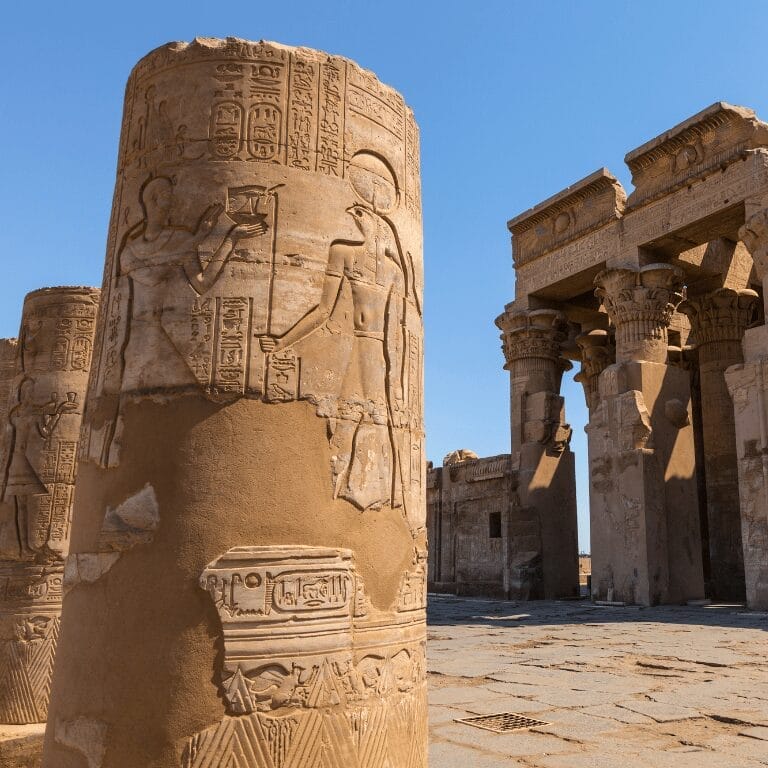There’s no better way to understand a place than through its food. In Egypt, that food is on the street – hot, cheap, loud, and rich in flavour and history. Egyptian street food isn’t just something you try; it’s something you remember.
Why Street Food Matters in Egypt
Street food in Egypt is more than just a snack between sights. It is part of everyday life. It feeds workers, brings families together, and welcomes newcomers. Vendors are found on every corner, each with a cherished family recipe handed down through generations. It is quick, fresh, and often better than what you would find in a restaurant.
The Essential Dishes of Egyptian Street Food
Koshari: The People’s Meal
Don’t let its simple ingredients fool you. Koshari is Egypt’s ultimate comfort food. A mountain of lentils, rice, macaroni, chickpeas, and fried onions is covered in tangy tomato sauce and spicy garlic vinegar. The flavours combine in the best way, giving every bite a punch of savoury, sour and crunch. Locals eat it with spoons, plastic containers, and extra chilli on the side. It’s cheap, filling, and loved by people from all walks of life. Koshari reveals more about Egypt than any guidebook.

Ta’ameya: Egypt’s Greener Falafel
While most falafel is made with chickpeas, Egypt takes a different approach. Ta’ameya is made from fava beans, which are ground with coriander, parsley, onion and garlic. The result is greener, creamier, and packed with herbs. Fried until crisp, it is often rolled into flatbread with pickles, salad and tahini. It’s a vegetarian dream without any compromises. You’ll smell it before you see it, fresh and hard to resist.
Ful Medames: A Slow-Cooked Staple
Ful is Egypt’s flavourful breakfast, but you can enjoy it any time of day. It’s prepared by simmering fava beans overnight in a sealed metal pot until they turn into a thick paste. The street-style version comes with lemon, olive oil, cumin, and occasionally a boiled egg or a piece of salty cheese. Served with baladi bread, it’s a satisfying meal that fills you up and keeps you content for hours.
Hawawshi: The Spiced Meat Pocket
Silk scarves, embroidered pillowcases and Ottoman-style kaftans make the bazaar a great place for fashion lovers. Whether you’re looking for gifts or packing your suitcase, the blend of modern and traditional textile designs is always inspiring.
Sweet Street Treats
After the savoury feast, Egypt provides a selection of sweet treats right on the pavement.
Zalabia: Tiny fried dough balls soaked in syrup. They are crispy on the outside and gooey on the inside. It’s impossible to eat just one.
Basbousa: A golden semolina cake drenched in orange blossom syrup and sometimes topped with almonds or coconut.
Konafa: A shredded filo dessert with a sticky filling, usually cream, nuts, or sweet cheese. One bite and you’re hooked.
These desserts are not delicate; they are rich, sticky, and meant to be eaten with your fingers, just like they should be.


When and Where to Eat Like a Local
You can find Egyptian street food at all hours, but each dish has its time to shine. Ful and ta’ameya are popular in the morning near markets and schools. By noon, koshari is the main attraction. As the sun sets, the aroma of hawawshi and fried sweets fills the streets. Cairo, Alexandria, and Luxor each have their twist. Just follow the lines and the scent of spices.
Eating Egypt’s Story, One Bite at a Time
To understand Egyptian street food is to understand Egypt itself. It’s honest, simple, and deeply connected to tradition. The food isn’t designed for tourists; it’s made for locals who enjoy it and know what good food is. When you eat on the street in Egypt, you’re not just tasting local ingredients, you’re experiencing daily life – one bite, one cart, one story at a time.
Explore Our Newest Travel Blogs & Tips
Morocco’s Atlas Mountains: A Cultural & Scenic Journey
Home Blog Morocco’s Atlas Mountains: A Cultural & Scenic Journey...
Things to Do in Cairo: Hidden Gems and Cultural Tours
Think Cairo is just about the pyramids? Think again. From...
Kom Ombo Temple Facts Every Egypt Traveller Should Know
Kom Ombo Temple is one of Egypt’s most unique sites,...









